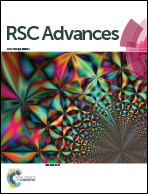Electrochemical properties of ultrafine TiO2-doped MoO3 nanoplates prepared by one-pot flame spray pyrolysis†
Abstract
Ultrafine TiO2-doped α-MoO3 nanoplates with a low thickness of 24 nm were prepared by one-pot flame spray pyrolysis, using water-soluble ammonium molybdate tetrahydrate as precursor. Pure MoOx nanopowders had a mixed morphology of rod-like and cube-like crystals, and a complex crystal structure composed of α-MoO3, β-MoO3, and Mo17O47 phases. However, addition of TiO2 influenced the morphology as well as the crystal structure of MoOx. The TiO2-doped MoOx powders had a regular nanoplate-like morphology and single-crystalline α-MoO3 structure. The initial discharge and charge capacities of the pure MoOx powders were 1481 and 998 mA h g−1 at a current density of 500 mA g−1. In contrast, 5 wt% TiO2-doped MoO3 nanoplates had high initial discharge and charge capacities of 1728 and 1171 mA h g−1, respectively. The discharge capacities of pure MoOx, 5 wt% TiO2-doped MoO3, and 10 wt% TiO2-doped MoO3 nanopowders after 200 cycles were 676, 1022, and 831 mA h g−1, respectively, and the corresponding capacity retentions measured from the second cycles were 68, 86, and 85%. The reversible discharge capacities of the TiO2-doped MoO3 nanoplates decreased from 1424 to 978 mA h g−1 as the current density increased from 200 to 1000 mA g−1, and the discharge capacity recovered to 1196 mA h g−1 when the current density returned to 200 mA g−1 after 50 cycles.


 Please wait while we load your content...
Please wait while we load your content...